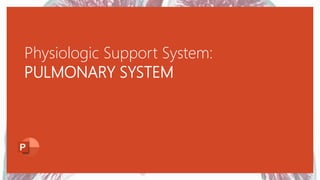
Pulmonary System.pptx
- 1. Physiologic Support System: PULMONARY SYSTEM
- 2. Structure and Function a. Functions i. Supply oxygen required in metabolism ii. Eliminate carbon dioxide produced in metabolism iii. Regulate hydrogen ion concentration to maintain acid- base balance.
- 3. Structure and Function Pulmonary Ventilation • Describes how ambient atmospheric air moves into and exchanges with air in the lungs. • PARTS • Lungs • Provides the surface between blood and the external environment. • Lung volume varies between 4 – 6 L and provides an exceptionally large moist surface. • Weighs 1kg, but if spread out, can cover a surface of 60 to 80 m2. • Alveoli • Lung tissue contains more than 600 million alveoli. • Elastic, thin-walled membranous sacs that is vital for gas exchange between the lungs and blood. • During rest 250 mL of oxygen leaves the alveoli per minute and enter the blood. • 200 mL of carbon dioxide diffuse into alveoli. • Trained endurance athlete – intense exercise – 200 times the resting oxygen uptake per minute.
- 5. Structure and Function Mechanics in Ventilation 1. Inspiration a. The pressure differential between the lungs and ambient air literally sucks air in through the nose and mouth and inflates the lungs. b. Lung filling depends on: i. The magnitude of inspiratory movements ii. The pressure gradient between the air inside and the air outside the lungs. 2. Expiration a. A passive process b. Decrease in chest cavity volume and compress alveolar gas; forces it out through the respiratory tract to the atmosphere. c. During exercise -
- 7. Static Volume LUNG VOLUME • Tidal volume (TV) – 500 mL • Volume of air moved in normal breathing cycle, either inspiratory or expiratory. • Inspiratory Reserve Volume (IRV) - 3000 mL • The maximum volume of air that can be inspired after TV. • Expiratory Reserve Volume (ERV) – 1100 mL • The maximum volume of air that can be inspired after TV. • Residual Lung Volume (RV) – 1200 mL • Amount of air left in the lungs after full expiration. LUNG CAPACITY • Total Lung Capacity (TLC) – 5800 mL • Total air volume in the lungs after maximum inspiration • Forced Vital Capacity (FVC) – 4600 mL • Maximum air volume moved in one breath from full inspiration to full expiration or vice versa. • Inspiratory Capacity (IC) - 3500 mL • Maximum air volume inspired. • Functional Residual Capacity (FRC) – 2300 mL • Volume remains in the lungs after a passive exhalation
- 9. Dynamic Volume • Ration of Forced Expiratory Volume to Forced Vital Capacity (FEV1.0/FVC) • Normal – 85% • Obstructive Lung Disease • Clinical Demarcation – 70% • Severe – 40% • Maximum Voluntary Ventilation (MVV) • Male – 140 to 180 L x Min-1 • Female – 80 to 120 L x Min-1
- 10. Pulmonary Ventilation & Alveolar Ventilation Pulmonary Ventilation • Normal rate of breathing averages 12 breaths per minute • 6L of air breathed per minute (minute ventilation) • An increase in depth or rate of breathing or both increases minute ventilation. • During maximal exercise TV commonly increases to 2.0 L and greater. • In several studies, the minute ventilation of elite endurance athlete can reach and exceed 200 L x Min-1 Pulmonary Ventilation • Refers to the portion of minute ventilation that mixes with air in the alveolar chambers. • About 30% of the air (resting TV) does not enter the alveoli and does not engage in air exchange.
- 12. Dead-Space • Anatomical Dead-Space • Conducting zone of the respiratory system • Physiologic Dead-Space • Portion of the alveoli with poor perfusion or inadequate ventilation. • May increase to 50% of resting TV • Inadequate perfusion during hemorrhage or blockage in the pulmonary circulation from an embolism or blood clot. • Inadequate alveolar ventilation in chronic pulmonary disease. • Adequate gas exchange and aeration of blood are impossible when the lung’s total dead space exceeds 60% of the lung volume.
- 14. Gas Exchange • Movement of gas in air and fluid • Henry’s law states that the amount of specific gas dissolved in a fluid depends on 2 factors: • Pressure differential and gas solubility to fluid
- 15. Gas Exchange (Internal and external gas exchange)
- 16. Regulation of Pulmonary Ventilation
- 17. Ventilatory Control at Rest • Neural Factors • Medulla oblongata (medial part) • Inspiratory neurons are located in this area of the brain. Lungs inflate because of diaphragm and external intercostals muscles. Inflation of the lungs stimulate stretch receptors in the bronchioles (information sent to the expiratory neurons at the medulla) that inhibit inspiration and stimulate expiration. • Humoral Factors • Chemical state of the body affects ventilation at rest. Variations in arterial oxygen and carbon dioxide partial pressures, and temperature activate sensitive neural units in the medulla and arterial system to adjust ventilation to maintain arterial blood chemistry.
- 18. Chemoreceptors (Aorta & Carotid Artery)
- 19. Ventilatory Control during Exercise • Chemical Factors • Increases in acidity and subsequent increases in CO2 and H+ during strenuous exercise provide an additional ventilatory stimulus that reduces alveolar Pco2 to 40 mmHg.
- 20. Ventilatory Control during Exercise • Nonchemical Factors • Ventilation increases so rapidly when exercise begins that it occurs almost within the first ventilatory cycle. • Minute ventilation gradually increases and approaches a steady level in relation to the demands for metabolic gas exchange. • When exercise stops, ventilation decreases rapidly to a point about 40% and then slowly returns to resting levels. • Neurogenic Factors • Cortical influence • Peripheral influence
- 21. Influence of temperature • An increase in body temperature directly excites neurons of the respiratory center and likely helps regulate ventilation in prolonged exercise.
- 22. Physiologic Support System: PULMONARY SYSTEM